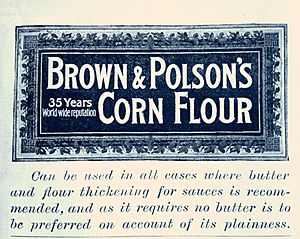Corn starch facts for kids
Cornstarch, also known as cornflour, is a type of starch. It comes from the maize grain, which you probably know as corn. It's made from the white, inner part of a corn kernel. When you mix it with water or milk, it feels unique. It's soft if you touch it gently, but it becomes firm if you push it hard. Cornstarch is often added to powdered sugar (like the kind used for frosting) to stop it from clumping together. That's why some recipes tell you to cook powdered sugar a little. This helps get rid of any raw cornstarch taste.
Mixing cornstarch with water creates a cool substance. It's called a dilatant fluid, or a "shear-thickening" fluid. If you hit it or squeeze it fast, it feels like a solid. But if you let it sit for a few seconds, it flows like a thick liquid. This makes it a popular science experiment in classrooms.
Contents
History of Cornstarch
Cornstarch was first discovered in 1840. A man named Thomas Kingsford found it in Jersey City, New Jersey, while working at a wheat starch factory. For many years, until 1851, cornstarch was mainly used for industrial purposes. This included starching laundry to make clothes stiff.
How Cornstarch is Used
Cornstarch is a very useful ingredient, especially in cooking.
Thickening Foods
One of its main uses is as a thickening agent in liquid foods. Think of things like soups, sauces, gravies, and custard. To use it, you usually mix cornstarch with a cold liquid first. This creates a smooth paste or "slurry." It's best to mix it with cold water because it can form stubborn lumps if mixed directly with warm or hot water.
Making Puddings
Cornstarch is also a common binder in puddings. Many packaged pudding mixes you find in stores contain cornstarch. You can easily make cornstarch puddings at home. They often turn out best when made using a double boiler. A basic cornstarch pudding can be made with just milk, sugar, cornstarch, and a flavoring.
Other Interesting Uses
Cornstarch has many uses beyond food:
- It's used in making products that are better for the environment. For example, in 2004, a Japanese company called Pioneer made a biodegradable Blu-Ray disc from cornstarch.
- It has been used as a safer replacement for talc in baby powder.
- It can be used to make bioplastics. These are plastics that break down more easily.
- Cornstarch is often used as an anti-stick agent on medical products. This includes natural latex items and medical gloves. It replaced talc because talc was thought to be harmful.
- Some food companies add cornstarch to products like cheese and yogurt. This can help reduce their production costs.
- When cornstarch is roasted in an oven, it creates a chemical called dextrin. Dextrin can be used as an adhesive (glue) or as a binder for fireworks.
A common substitute for cornstarch is arrowroot. You can usually use the same amount of arrowroot as cornstarch in recipes.
How Cornstarch is Made
Making cornstarch involves a process called wet milling. Here's a simplified look at how it's done:
- First, the corn is steeped in water for 30 to 48 hours. This allows it to ferment a little.
- Next, the cereal germ (the part that sprouts) is separated from the endosperm (the starchy part). Both are then ground separately while still wet.
- The starch is then washed out from each part.
- The starch is separated from other parts like the corn steep liquor, germ, and fibers. This is often done using special machines called hydrocyclones and centrifuges.
- Finally, the starch is dried.
- Any leftover parts from this process are often used for animal feed or to make corn oil. Sometimes, the starch is also changed a bit (modified) for specific uses.
Names for Cornstarch
Cornstarch has different names depending on where you are in the world:
- In the United States and Canada, it's called cornstarch.
- In the United Kingdom, Ireland, Israel, and some Commonwealth countries, it's called cornflour. This is not to be confused with cornmeal, which is a different product.
- In many parts of Europe and Latin America, it's often called maizena. This name comes from a popular brand. Countries like the Netherlands, France, Germany, Brazil, and Spain use this name.
Images for kids
-
An advertisement from the US Food Administration in 1918. It says corn starch is "wholesome" and "nutritious."
See also
 In Spanish: Maicena para niños
In Spanish: Maicena para niños





